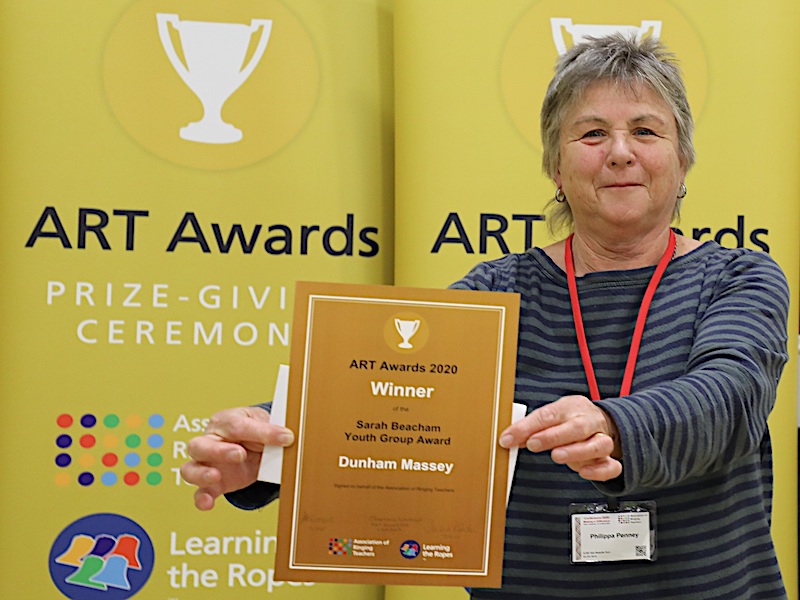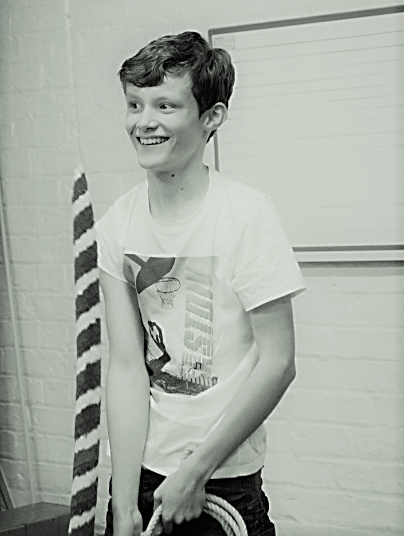The Sarah Beacham School & Youth Group Award – Dunham Massey
Background
Dunham Massey Change Ringers, St Margaret’s Church, Dunham Massey, Altrincham.
The band have taken on two groups of youngsters. The first group of six began in February 2018 and consisted of 6 children, with ages ranging from 13 to 15. The second group of six began they following January and consisted of 6, with ages ranging from 11 to 16.
The number of adults has varied depending on the point in the development of the tower. In general, they have a core team of about 8 adults, from 4 or 5 towers, who support the band. At some stages they have drawn on far more.
Currently ages range from 12 to 17. At present, the ringing takes place just once on a Sunday with a practice night on a Monday. When a new group is launched additional practices are run. They work very closely with neighbouring tower Bowdon and two of the ringers that have been trained have gone on to ring there.
Achievements
The story is taken up by Tower Captain Andrew Darling ...
In 2014 I switched into a new career as a Primary School Teacher. With a bit of a commute and knowing that the first years in this profession could be all-encompassing, I stepped down as Tower Captain. With no one else willing to take on the mantle of Tower Captain, the bells of Dunham Massey in Altrincham became silent. The ringers began to disband with some going to Bowdon – another local tower – and others stopping ringing altogether.
After three years working in Oldham, I changed to a school much closer to home. I had given no thought to ringing until I was coaxed and cajoled along to Bowdon’s annual Autumn ringing trip in the October of 2017. It gradually dawned on me that it was all a ploy by the Bowdon ringers. By the end of the day we had arranged for a working party to get the bells ringable again and to start running a monthly practice. And as the days and weeks went on, I began to feel that old ringing itch, an itch I had never been very good at ignoring. I began to feel the urge to get Dunham ringing properly again and I had long wanted to create a Youth Band. If this was ever going to happen, now was the time.
But a confession: although the scale of the challenge was bigger, this wasn’t the first time we’d tried to revive this band. In 2011, after much of the original band had moved off to a tower closer to Manchester, I had taken on the mantle of Tower Captain for the first time. We’d started training a couple of youngsters and two adults and although it had gone well to begin with it had slowly fizzled out because we had struggled to get a steady band. We had learnt some lessons from this, that we needed to learn from if we were going to be successful second time around:
- ALWAYS make sure that you have enough experienced ringers to run a beginner’s practice – you only have to have one non-practice for learners to lose faith. Momentum is everything!
- Youngsters need to feel that they are progressing – you can’t just have them floating around ringing bad call changes forever.
- If you are going to train youngsters it’s better to train A LOT of youngsters. At the end of the day, youngsters don’t ring for the joy of ringing, they come along to be with their friends. Two kids surrounded by OAPs does not maketh a fun road to travel down.
- Linked to 3, children ring as much for the social aspect as for the ringing itself. We would need to build social activities into our planning.
So how would we address these challenges? Here were the answers that we came up with:
- Be uber-organised – get a large, strong core of ringers, from a variety of different towers, who would be willing to help out and make sure that we checked availability each week. WhatsApp hadn’t been widely used last time we were running practices but it seemed like the ideal medium for facilitating this kind of organisation on a week-by-week basis. Most towers take a very laissez-faire approach to practices but I was convinced that this was a dangerous tactic.
- Business consultants sometimes talk about Innovations in Infrastructure – introducing new structures that would enable and allow the fast progress that we wanted. When I was a ringer in Darlington, I had heard how the ringers at Northallerton had trained their young band rapidly by introducing additional practices. Why not do something similar at Dunham? To build initial momentum we decided that we would need to run 2 or 3 practices a week, to get through the bell handling phase. Then, for the move into call changes we would run a daily Boot Camp for a week during the Easter Holidays. This would involve a number of 1-hour sessions, with two learners at each session, surrounded by steady, reliable ringers. That would give our young learners an intense amount of practice to move them on and this structure was essential if we were going to get a large number of youngsters to progress.
- With no band to speak of, I figured that we needed to train a lot of kids. Four felt like an optimal number, but given that some were likely to drop out we decided to go for six. Some would raise their eyebrows at this ambition, but I’d already done some of the groundwork for this. Before going into teaching I had run the Sunday School at St Margaret’s. I’d written and directed plays and run a series of events including Traidcraft Big Brews, Big Tops where we introduced children to circus skills, and Big Draws, where we created huge artworks for the church. By the time I stepped down and handed the Sunday School over, there were 70 children on the books and sometimes we had up to 47 children coming to church on a Sunday morning. The Sunday School had continued after I left and this meant that there were still many children within the congregation who might be interested in taking up ringing. In addition, my 13-year-old son was about the right age to start ringing, as was the daughter of one of the other ringers. It wasn’t really hard to identify a core team of six learners.
- We decided that we should try to take the kids on four tours each year. A mini-tour in March and December, a summer tour in June, and then tag onto the tour of the Bowdon ringers in the Autumn. In addition, we also pencilled in evening trips to the Lichfield mini-ring when it visited the Cheshire Show each year … and a trip to one of the summer open evenings at Liverpool Cathedral.
A final challenge was going to be setting up a simulator. If we were going to do all the practising that we wanted to do, we were going to need a simulator or the neighbours would rise up in protest. Mooting the idea to one of the Bowdon ringers piqued their interest and work on this began to run in parallel to all our other efforts.
As ever in life, coming up with all of these ideas and aspirations was easy, getting things moving was a bit more of a challenge. I spent a Saturday morning speaking to all the ringers in the local area, to get a sense of who was willing to support our plans and making sure that we had a quorum. We then spent a morning attaching new ropes to the bells and adjusting them for length. And then we were off.
We were on a tight schedule. Our first bell handling practice was on 26th February 2018. We needed the youngsters all to have strong bell handling skills in time for the Boot Camp in the Easter Holidays. That was about five weeks of hard effort. We began by ringing two or three times a week. I’d always been a stickler for excellent bell handling and we worked them hard using a traditional approach of hand stroke, back stroke, both strokes together, and then a variety of games to build confidence in adjusting rope length while ringing and so on. It wasn’t all plain sailing. One of the youngsters was dyspraxic and found the whole ringing action incredibly challenging, but we had started with six learners and six weeks later they were all still enthusiastic.
However, ensuring that we had enough adults to people the practices did prove problematic. Many of the local ringers, while very supportive, were either retired and often away on holiday, or professionals who were frequently working away. Learning from my experience six years earlier, we made a point of WhatsApping each week to ensure that we had enough ringers for each practice but then came the week when we only had two adults available. Panicking slightly, I put a call-out to the Branch and adults from far and wide stepped in to support us. From that week on a group of 4 new helpers started coming week-in-week-out. Without them we would have struggled to keep our momentum and our initiative may well have come to an end.
This support enabled us to get to the Easter Holidays intact. While a nightmare to organise, the Boot Camp went swimmingly. Owing to holidays, only four youngsters could attend but we ran two, one-hour sessions a day, for a week, with two learners in each session. By the Friday we had four young ringers able to ring in rounds and on the Sunday, we rang the bells for service for the first time in over 3 years. It was hugely rewarding.
In the May we had our first mini-ringing tour, followed by a trip to a Bowling Alley. The trip did wonders for their confidence and for cohesing the group and then we began putting in plans for a second Boot Camp in the summer. This one was to be aimed at helping the learners take the step into change ringing and Bob Doubles in particular. The format for this was much the same and it had the impact that we had been hoping for. It still meant that the following Autumn required a huge amount of Bob Doubles, enough to send us all round the bend, but it did accelerate our overall progress and led nicely into our Christmas mini-tour. This time three towers in Macclesfield followed by an Escape Room.
But … we still didn’t have enough ringers to guarantee that we’d have enough to ring each Sunday. Furthermore, if we were going to create a Youth Tower, we would need to keep recruiting children or, in seven years’ time, we’d be back to having no band. To address this, we planned to take on a second group of youngsters. However, before we began with these, we decided that we should hone our teaching by hosting an ART bell handling course at Dunham. This brilliant day really transformed our approach and when we started training the next six ringers at the beginning of January 2019, we felt far more confident.
This time we had four 11-year olds, a 13-year-old and a sixth former. Based on the ART course we recognised that a learner needed 7 or 8 hours on a bell in order to master bell handling and so we planned in two ringing sessions a week, initially. One of these was on a Wednesday evening and the next on a Saturday morning, the simulator freeing us up to run far more practices. We ran a mini-boot camp during the February half term, for a couple of days, and continued running this additional practice into the summer holidays. It was exhausting but we felt that integrating the new ringers into the main practice too early, would slow down the development of all the learners and might lead to us losing some ringers. As it was, maintaining both practices ensured that all the learners continued to progress rapidly.
In the Spring, the Guild began running youth practices with the aim of putting in a band for the National Youth Striking Competition in the summer. Four of our young ringers began to go to this and two took part in the competition in the summer.
The summer saw us running a second trip to the Lichfield Mini-Ring, to Liverpool Cathedral and our first full day ringing trip.
By the time that we came to our third Boot Camp in the summer of 2020, we had progressed 2 of the original six ringers from Plain Bob Doubles, to Bob Minor, Grandsire Doubles and Little Bob Minor, with the others following at different points behind. The Boot Camp consolidated this progress and allowed us to begin to make the leap into Surprise ringing. It also allowed us to draw back the young ringers from our 2011 experiment. It was hugely ambitious, running for 8 days and comprising some 19, one-hour sessions. It required support from across the branch and beyond, but by the end if felt that we had secured the future of the band and laid some solid foundations for our further development. One of the most rewarding things about this third Boot Camp was that some of the first tranche of ringers were able to be ‘experienced’ ringers themselves and to assist the new learners. In fact, often they were more reliable than ringers who had been part of the Exercise for 20 years or more.
Sadly, of our second intake, only four had continued to this point, but with 10 ringers out of 12, we felt that our retention rates, at 83%, were pretty impressive.
In the four months since the Summer a handful of other things have been accomplished:
- We have begun to ring a handful of quarter peals to consolidate learning.
- We have integrated the new ringers into the main practice. This has required ongoing tweaking and it has settled into a pattern where newer learners come for the first hour and a quarter with more established learners arriving later.
- We now have a band capable of ringing Surprise Minor most weeks as well as touches of Plain Bob Triples and plain courses of Grandsire Triples and we are ambitious to deepen and strengthen this.
- We hosted an ART conducting workshop in November and two of our Young Learners attended this.
- We started training six youngsters to ring.
- Four are still ringing and they are now all able to ring Bob Doubles inside.
- One of these is able to ring touches.
- They have all rung Plain Hunt on 7.
Of the six youngsters who started learning in 2018:
- Two are very competent at ringing touches of Cambridge Surprise Minor.
- An additional one can treble to Surprise methods.
- Five can ring plain course of Plain Bob Triples.
- Four are able to ring touches of Plain Bob Triples.
- Four are able to ring Plain Courses of Plain Bob Triples.
- Five can ring touches of Plain Bob Minor.
- Five can ring touches of Grandsire Doubles.
- They can all ring Plain Bob Doubles.
- Two young adults, who we started to teach in 2011, have now returned to ringing.
Future plans and aspirations
We have a number of aspirations for 2020:
- We are hosting an ART Module 2C course on 18th January to enrich our teaching further.
- We are planning to ring more regular quarter peals to consolidate progress.
- We have a glut of learners at the Plain Bob Doubles stage so we will be running some additional practices to accelerate them out of this.
- We will be running some focussed surprise practices to expand the number of ringers able to do this across both our tower and Bowdon’s.
- We are keen to begin to step towards ringing Surprise Major and Stedman Triples by the end of the year.
- We will also be looking to start a third group of learners in September.
- We will be looking to buy a set of hand bells in the near future both for method ringing but also for tune ringing during church services and for charity during the Christmas period.
- We will be encouraging some of the youngsters to start getting involved in steeple keeping activities.
- Running a ringing Open Day to develop a dialogue with the wider church and local community.
- The East Cheshire Branch has introduced the role of a Youth Officer who is launching monthly Youth Practices from January 2020. Our Young Ringers are planning to attend these and will probably form the core of this to begin with.We currently have more young ringers at Dunham and Bowdon than the rest of the East Cheshire Branch put together.
- Some of the youngsters will be supporting Bowdon with additional practices for their learners.
- We will be entering at least one band into the Branch Striking Competition this year and encouraging the young ringers to attend nearby Branch Practices.
Sponsored by the Sarah Beacham
Memorial Trust
» The Sarah Beacham Memorial Trust
Winner: Dunham Massey
Runner Up: Old Brampton Church Bellringers


